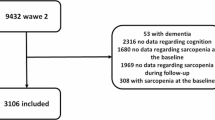Abstract
Background and aims
Frailty is a common situation that often influences clinical outcomes, disability or institutionalization. The present study aims to evaluate the weight of hand grip strength (HGS) reduction in terms of death or re-hospitalizations, at 3-month and 1-year follow-up.
Methods
Observational study performed on hospitalized patients aged 65 years or more. The HGS was measured twice: at hospital admission and discharge. The statistical analysis was performed using SPSS, version 18 for Windows. The χ 2 test was used to evaluate the relationship between HGS and different variables. Three-month and 1-year survival and hospital re-admissions have been analyzed using Kaplan–Meier’s curves. The analyses have been adjusted for age and gender.
Results
A total of 201 hospitalized patients have been recruited. Of them, 76 were males. The mean age was 81.79 ± 7.409 years. Of all the patients enrolled, 66.2 and 45.3 % did not show any impairment performing activities of daily living and instrumental activities of daily living, respectively. Moreover, patients were not cognitively impaired [SPMSQ (short portable mental status questionnaire ) m ± SD = 1.47 ± 0.794]. At 3-month follow-up patients with strength reduction had a relative risk of death more than seven times higher than the others (p = 0.047). Same results were observed at 1-year follow-up (95 % CI = 1.85–9.84; p = 0.000). There was no significant relationship between HGS and hospital re-admissions.
Conclusions
Effects of strength reduction occurring during a period of hospitalization could produce effects even after hospitalization itself. This increases the relevance of maintaining usual physical performance of patients even during hospitalization.



Similar content being viewed by others
References
Guralnik JM, Simonsick EM, Ferrucci L et al (1994) A short physical performance battery assessing lower extremity function: association with self-reported disability and prediction of mortality and nursing home admission. J Gerontol 49(2):M85–M94
Guralnik JM, Ferrucci L, Simonsick EM et al (1995) Lower-extremity function in persons over the age of 70 years as a predictor of subsequent disability. N Engl J Med 332(9):556–561
Bohannon RW (2008) Hand-grip dynamometry predicts future outcomes in aging adults. J Geriatr Phys Ther 31(1):3–10
Isaia G, Maero B, Gatti A et al (2009) Risk factors of functional decline during hospitalization in the oldest old. Aging Clin Exp Res 21(6):453–457
Roberts HC, Syddall HE, Cooper C et al (2012) Is grip strength associated with length of stay in hospitalised older patients admitted for rehabilitation? Findings from the Southampton grip strength study. Age Ageing 41(5):641–646
Xue QL, Walston JD, Fried LP et al (2011) Prediction of risk of falling, physical disability, and frailty by rate of decline in grip strength: the women’s health and aging study. Arch Intern Med 171(12):1119–1121
Petersen P, Petrick M, Connor H et al (1989) Grip strength and hand dominance: challenging the 10% rule. Am J Occup Ther 43(7):444–447
Mathiowetz V, Kashman N, Volland G et al (1985) Grip and pinch strength: normative data for adults. Arch Phys Med Rehabil 66(2):69–74
Conflict of interest
The authors have no conflicts of interest to disclose.
Author information
Authors and Affiliations
Corresponding author
Rights and permissions
About this article
Cite this article
Isaia, G., Greppi, F., Pastorino, A. et al. Predictive effects of muscle strength after hospitalization in old patients. Aging Clin Exp Res 25, 633–636 (2013). https://doi.org/10.1007/s40520-013-0162-2
Received:
Accepted:
Published:
Issue Date:
DOI: https://doi.org/10.1007/s40520-013-0162-2




